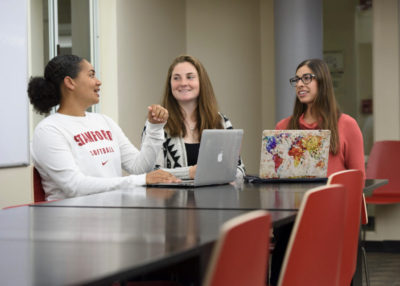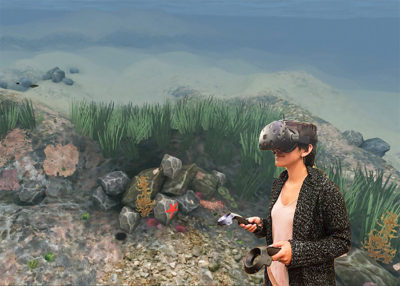Department of Communication faculty members are the founders or co-founders of many multi-disciplinary research labs and centers, including: Center for Deliberative Democracy, Political Communication Lab, Political Psychology Research Group, Stanford Computational Journalism Lab, Stanford Social Media Lab, and Virtual Human Interaction Lab. These labs employ undergraduates and graduate students from multiple departments, extending the reach of the discipline. VHIL has averaged over 1,200 visitors per year over the last three years, introducing numerous constituencies to research about virtual reality.

Journalism classes increasingly generate collaborations across campus. Cheryl Phillips led a mix of undergraduate and graduate students to do freedom of information requests in all fifty states for data on police stops. The data became the basis for collaboration with Assistant Professor Sharad Goel in the School of Engineering, generated academic publications for statistics PhD students, and resulted in creation of a data repository used by journalists across the country to write stories about policing. Undergraduates writing about public affairs may see their stories shared on the department’s Peninsula Press website, taken up by KQED or SFGate, or even copied by national outlets (such as the story on the commutes of Stanford staff, originally done at Peninsula Press and then redone on ABC’s 20/20 by Diane Sawyer). Classes on data journalism and computational journalism are attracting Computer Science majors, leading some to intern at outlets such as ProPublica and Reuters.
All Comm majors are required to take Comm 106 Communication Research Methods. Assistant professor Jennifer Pan has designed the class so that students participate in small-scale research studies,as described recently in Stanford News. In Professor Pan’s Comm 157, students work in teams to develop substantive research projects which have included Use of Twitter for Social Mobilization in Saudi Arabia, How Autocrats use Social Media: the Case of Hugo Chavez, Reporting on Human Trafficking: Comparison of Media Coverage in India and Pakistan, and Online Citzen Complaints and Government Responsiveness: A study of Shanghai Municipal Government.
Assistant Professor Gabriella Harari has a research lab that studies how people’s personalities get expressed in the physical and digital contexts of everyday life. Professor Harari recruits students to her lab who want to contribute to interdisciplinary research projects at the intersection of communication, psychology, and computer science. Students in the lab contribute to research examining what digital media technologies (e.g., social media, smartphones, wearables) reveal about people’s behavioral patterns and psychological states. For example, in one project students examined how self-tracking technologies (e.g., health apps, wearable devices) can be used to promote self-insight and positive changes in behavior. Students with interests in programming and human-computer interaction (HCI) helped develop personal informatics tools that visualize the self-tracked data.

Undergraduate students working with Professor Jeremy Bailenson get substantial opportunities to do research and publish. Each year, his Virtual Human Interaction Lab (VHIL) chooses about 10 undergraduate students to join their programming team for the full academic year. The time commitment is roughly equivalent to a 3-unit course (approximately 10 hours per week), and these students receive quarterly stipends instead of course credit. These students participate in the Virtual Reality Intensive Training Seminar (VRITS), which runs for two weeks before the start of school in September, and then work as programmers on research studies. This training is supported by a grant from VPUE, and the payoffs in undergraduate research are readily apparent. Undergraduates who entered the lab via VRITS and then coauthored journal articles with Bailenson include Nicole Lundblad, Christine Tataru, Jimmy Lee, Tony Ricciardi, Joseph Binney, and Felix Chang. Undergradutes who published with Bailenson and then worked in the VHIL lab full-time include Josh Bostick, Shawnee Baughman, and Elise Ogle. Undergrads who became PhD students in the lab and published articles include Ketaki Shriram, Jakki Baily and Kathryn Segovia.
Professor Jon Krosnick’s Political Psychology Research Group involves undergraduates in all phases of their research work. PPRG studies the psychology of political communication by conducting laboratory experiments, field experiments, experiments embedded in surveys, and high-quality national surveys of representative samples of American adults. The team has examined the impact of candidate name order on election outcomes, the role that pre-election polls play in influencing the outcomes and interpretations of American elections, the steps that researchers can take to be sure that pre-election polls and other surveys yield accurate measurements, changes in American public opinion on global warming, and more. Undergrads work closely with grad students, post-docs, and research staff, as well as Professor Krosnick, to gather data, program and optimize the functioning of questionnaires online, build datasets, conduct statistical analyses, write up research reports, and make presentations of research findings at national conferences. Undergraduates are either paid for their work by the hour or earn course credits, and they have often been coauthors (sometimes even first author) of peer-reviewed publications of the results of projects they worked on. Undergrads who worked with PPRG have gone on the graduate school, law school, business school, and careers using their research skills with many different types of firms in the private sector and in government.
Professor Jeff Hancock’s Stanford Social Media Lab (SML) works on understanding psychological and interpersonal processes in social media. The team specializes in using computational linguistics and experiments to understand how the words we use can reveal psychological and social dynamics, such as deception and trust, emotional dynamics, intimacy and relationships, and social support. Recently the team has begun working on understanding the mental models people have about technologies, including algorithms, social media and AI, along with the ethical issues associated with computational social science. Each quarter, SML chooses five undergraduate students to receive individualized psychology research training. They work closely with Professor Hancock and the research team and participate in all aspects of the research process: from research questions and hypotheses development, to research design, data collection, data analysis, and manuscript writing. Undergraduates that have worked in the SML are co-authors and first authors on conference papers and peer-reviewed publications and were admitted to top graduate programs nationwide.
Recent faculty-undergraduate collaborations that have resulted in journal articles published or under submission include Prof. Byron Reeves’s work with Prof. Jeff Hancock and a team of six undergraduates to examine empirical studies of social responses to robots; a project that an undergraduate started in Hancock’s Deception and Trust class that became the basis for her Coterm thesis and two articles submitted for publication; and articles that Prof. Jon Krosnick has coauthored with undergraduates on topics such as voter turnout, issue priorities, and the impact of candidate name-order effects in balloting.
